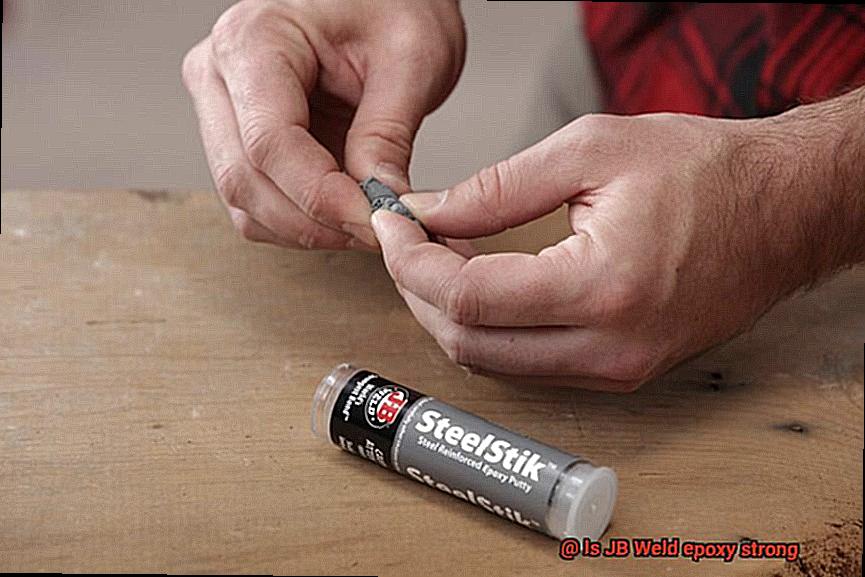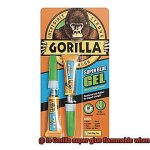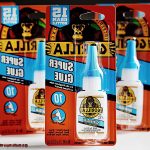Sick and tired of those wimpy adhesives that couldn’t hold a feather together? Well, buckle up because today we’re taking a deep dive into the realm of JB Weld epoxy and its legendary strength.
Whether you’re fixing up a busted tool, sealing pesky leaks, or even constructing something from scratch, you need an adhesive that’s tougher than nails. And let me tell you, JB Weld epoxy is no ordinary glue.
This stuff is like the Incredible Hulk of adhesives – ridiculously strong, endlessly versatile, and capable of bonding just about anything under the sun. So if you’re wondering whether JB Weld epoxy lives up to its mighty reputation, stick around as we uncover the science behind its unbreakable resilience and discover the projects where it truly flexes its muscle.

Prepare to have your mind blown.
What is JB Weld Epoxy?
Contents
- 1 What is JB Weld Epoxy?
- 2 Bond Strength of JB Weld Epoxy
- 3 Shear Strength of JB Weld Epoxy
- 4 Temperature and Chemical Resistance of JB Weld Epoxy
- 5 Factors that Affect the Strength of the Bond Created by JB Weld Epoxy
- 6 Proper Surface Preparation for Optimal Results with JB Weld Epoxy
- 7 Advantages of Using JB Weld epoxy
- 8 Conclusion
When it comes to adhesive, there is one name that stands above the rest – JB Weld Epoxy. This remarkable glue has earned a reputation for its exceptional strength and durability, making it the top choice for DIY enthusiasts, mechanics, and professionals. In this article, we will delve into the world of JB Weld Epoxy and explore why it has become the go-to adhesive for those seeking an unbreakable bond.
Exceptional Strength:
- JB Weld epoxy forms a bond that surpasses the strength of the materials being joined.
- With an impressive tensile strength of 5020 PSI, it can withstand significant pulling forces.
- Its shear strength of 1800 PSI ensures a secure bond even in applications with lateral forces.
Versatility:

- Designed to bond various surfaces such as metal, wood, and plastic.
- Ideal for repairing broken tools, automotive parts, sealing leaks, and filling gaps.
- An indispensable tool in any toolbox due to its versatility.
Temperature and Chemical Resistance:
- Capable of withstanding extreme temperatures ranging from -67°F to 500°F (-55°C to 260°C).
- Resistant to chemicals like gasoline, oil, transmission fluids, and water.
- Ensures the bond remains intact even in harsh environments.
Ease of Use:
- Mixing the two components of JB Weld epoxy is a simple process.
- The adhesive spreads easily for full coverage and a strong bond.
- Following manufacturer’s instructions guarantees optimal results.

Bond Strength of JB Weld Epoxy
Enter JB Weld epoxy, the adhesive that surpasses all others. In this article, we will delve into the factors responsible for the extraordinary bond strength of JB Weld epoxy, making it a must-have for any DIY enthusiast or professional.
Factor 1: Material Matters:
When it comes to bond strength, the type of materials being bonded is crucial. JB Weld epoxy effortlessly joins metal, wood, plastic, ceramic, and more. However, it’s important to note that some materials create stronger bonds than others.
Metals, for instance, form an incredibly sturdy bond with JB Weld epoxy, while wood and plastic surfaces may have slightly different bonding strengths.
Factor 2: Surface Preparation:
Preparation is key to achieving a strong bond. Before applying JB Weld epoxy, make sure the surfaces to be bonded are clean and free from contaminants. Dirt, oil, and grease can hinder the adhesive properties of JB Weld epoxy.
It is recommended to thoroughly clean the surfaces using a suitable cleaning agent or solvent. Additionally, roughening the surfaces with sandpaper or a wire brush enhances bonding strength by providing a larger surface area for the epoxy to adhere to.
Factor 3: Curing Time:
Patience is a virtue when it comes to achieving maximum bond strength with JB Weld epoxy. After applying the adhesive and joining the surfaces together, it is essential to allow sufficient time for the epoxy to cure and harden. The curing time may vary depending on factors such as temperature and humidity. Following the manufacturer’s instructions regarding curing time is crucial for optimal bond strength.
Applications Galore:
JB Weld epoxy’s exceptional bond strength makes it a go-to choice for various industries and DIY projects. Repairing cracks in engine blocks, fixing broken metal parts, and bonding plastic components are just a few examples of its versatility. It can even be used for creating sculptures or artwork. JB Weld epoxy’s reliability and strength make it a must-have adhesive in any toolbox.
Shear Strength of JB Weld Epoxy
JB Weld epoxy is a force to be reckoned with when it comes to shear strength. This remarkable adhesive has gained a reputation for its high performance and durability, making it a go-to choice for bonding metals and other materials in a wide range of applications.
So, what exactly is shear strength? Picture this: it’s the resistance a material has to forces that cause one layer to slide or shift relative to another layer parallel to the applied force. In simpler terms, it’s all about keeping things together, folks.

To determine the shear strength of JB Weld epoxy, experts conduct tests like the ASTM D1002 standard test method. This involves bonding two metal specimens together using JB Weld epoxy and applying a force parallel to the bond line until failure occurs. The amount of force required to cause failure is then measured – and that’s where the magic unfolds.
Prepare to be amazed by the mind-blowing data. In one study comparing various adhesives, JB Weld epoxy flexed its muscles with a shear strength exceeding 3000 psi. That’s right, it outperformed other popular glues like super glue and epoxy putty. Impressive, right?
But wait, there’s more. A third-party testing laboratory reported an average shear strength of approximately 3600 psi when JB Weld epoxy was put to the test on aluminum substrates. That’s some serious muscle right there.
However, keep in mind that shear strength can be influenced by factors like temperature, humidity, and even the specific materials being bonded. That’s why it’s crucial to follow the manufacturer’s instructions and conduct proper testing for your specific application.
Temperature and Chemical Resistance of JB Weld Epoxy
JB Weld epoxy is a renowned adhesive known for its exceptional strength and durability. But how does it fare when exposed to extreme temperatures or harsh chemicals? Let’s delve into the temperature and chemical resistance of JB Weld epoxy to find out.
Temperature resistance is where JB Weld epoxy truly shines. This robust adhesive can withstand continuous exposure to temperatures as high as a scorching 550°F (287°C). Automotive engine repairs, exhaust systems, and industrial machinery can all benefit from its impressive heat tolerance. However, extended exposure to extreme heat can weaken the epoxy bond over time. So while JB Weld epoxy is a formidable warrior against high temperatures, it’s important to exercise caution in extreme conditions.
When it comes to chemical resistance, JB Weld epoxy proves itself as a tough contender. It resists most common liquids such as water, gasoline, oil, hydraulic fluids, and various solvents. Whether you’re fixing your car, dealing with plumbing issues, or working with industrial machinery, you can trust JB Weld epoxy to stand up against these substances.
However, not all chemicals play well with this super glue. Strong acids or bases have the potential to degrade or weaken the epoxy bond. Therefore, before embarking on a project involving harsh chemicals, consult the manufacturer’s guidelines or perform a compatibility test to ensure a successful bond.
It’s worth noting that extended exposure or repeated immersion in certain chemicals may gradually degrade the epoxy bond. If chemical resistance is crucial for your application, consider the specific environment and potential long-term effects before relying solely on JB Weld epoxy.
Factors that Affect the Strength of the Bond Created by JB Weld Epoxy
In the realm of adhesives, few can rival the strength and versatility of JB Weld epoxy. Whether you’re mending a broken tool or fashioning something new, JB Weld epoxy is your trusty sidekick. But what exactly determines its remarkable bond strength? Let’s delve into the enigmatic secrets that make JB Weld epoxy an unstoppable force.
Surface Preparation: The Foundation for Success
Before applying JB Weld epoxy, meticulous surface preparation is paramount. Cleanliness reigns supreme; rid the surfaces of dust, oil, grease, or rust. Employ a degreaser to banish contaminants, sand the surfaces for enhanced adhesion, and wipe them down with a solvent to eliminate residue. By setting the stage with diligent surface preparation, you pave the way for maximum bond strength.
Mixing Ratio: The Harmony of Resin and Hardener
Achieving optimal bond strength necessitates precise mixing of JB Weld epoxy’s components: resin and hardener. Vigilantly adhere to the manufacturer’s instructions to ensure you achieve the recommended mixing ratio. Deviating from this ratio jeopardizes bond strength. Take your time, mix thoroughly for uniformity and robustness.
Curing Time and Conditions: Patience is Key
Once applied, JB Weld epoxy requires ample time to fully cure and harden. Curing time varies based on temperature, humidity, and bond line thickness. Don’t rush this pivotal step; grant your epoxy the patience it deserves to reach its pinnacle of strength. Abide by the manufacturer’s guidelines regarding curing conditions such as temperature and ventilation for optimal outcomes.
Material Compatibility: A Match Made in Bonding Heaven
JB Weld epoxy is designed to bond various materials like metals, plastics, ceramics, and more. However, each material possesses unique surface characteristics and chemical compositions that can influence bond strength. Before plunging ahead, conduct a small compatibility test or consult the manufacturer’s guidelines to ensure harmony. A strong bond commences with the right match.
Bond Line Thickness: The Goldilocks Principle
When applying JB Weld epoxy, remember that thicker isn’t always mightier. Excessive thickness can actually weaken the bond. Aim for a recommended bond line thickness of around 0.10 to 0.15 inches (2.5 to 3.8 mm) for optimal adhesion and robust bonding.
Proper Surface Preparation for Optimal Results with JB Weld Epoxy
Achieving optimal results with JB Weld epoxy requires proper surface preparation, a crucial step akin to a painter priming their canvas before creating a masterpiece. Let’s delve into the essential steps and understand why each one is vital.
- Clean the surfaces: Just as sticking two pieces of paper together with dirt and grease in between would fail, removing contaminants like dirt, grease, oil, or other substances is essential. A degreaser or mild detergent and water can work wonders here.
- Roughen the surfaces: Imagine creating tiny crevices for the epoxy to grip onto, much like a climber finding handholds on a rough rock face. Sanding or using a wire brush creates a textured surface that enhances the bond.
- Enhance adhesion: Non-porous materials often require an extra boost for adhesion. Solvent-based primers or adhesion promoters ensure a strong connection between the epoxy and the substrate, reinforcing the bond.
- Ensure proper fit and alignment: Like puzzle pieces fitting seamlessly together, the surfaces should be even, clean, and free from debris or loose particles that could compromise the bond. Prioritize meticulous alignment before applying the epoxy.
- Consider temperature and humidity: JB Weld epoxy thrives in an environment where temperatures range from 50°F (10°C) to 80°F (27°C). Extreme temperatures can hinder curing, weakening the bond. Aim for that ideal sweet spot.
- Mind moisture levels: JB Weld epoxy prefers clean, dry surfaces. Moisture interferes with bonding and weakens it. Avoid applying the epoxy in humid conditions or on wet surfaces to ensure optimal results.
- Follow instructions diligently: Each JB Weld product may have specific guidelines for surface preparation, application techniques, and curing times. By thoroughly reading and understanding these instructions, you’ll be well-equipped to achieve prime results.

Advantages of Using JB Weld epoxy
Unleash the Power of JB Weld Epoxy: The Unmatched Strength, Durability, and Versatility
Introduction:
Prepare to revolutionize your bonding projects with the extraordinary power of JB Weld epoxy. This adhesive marvel has earned a prestigious reputation for its exceptional performance and reliability across a wide range of applications. Whether you’re a seasoned craftsman or an avid DIY enthusiast, JB Weld epoxy boasts numerous advantages that make it an essential addition to your toolbox.
Unmatched Strength and Durability:
Prepare to be astounded by the Herculean strength of JB Weld epoxy. This adhesive is renowned for its ability to bond various materials together, including metal, wood, plastic, ceramic, and more. Its unmatched versatility empowers you to tackle a multitude of projects with unwavering confidence, knowing that your bonds will endure the test of time.
Withstands Extreme Temperatures:
From searing summers to icy winters, JB Weld epoxy laughs in the face of temperature challenges. With an impressive temperature resistance of up to 550 degrees Fahrenheit (287 degrees Celsius), this adhesive is tailor-made for applications that involve high heat or intense exposure to sunlight. Whether you’re repairing an engine part or fixing an outdoor fixture, JB Weld epoxy has got your back.
Chemical Resistance:
Fearlessly confront the most unforgiving chemicals with JB Weld epoxy. This adhesive masterfully resists the likes of gasoline, oil, hydraulic fluids, acids, and more. It’s the perfect choice for automotive repairs, plumbing projects, and other applications where exposure to different substances is commonplace.
Quick Curing Time:
In the fast-paced world of project completion, time is of the essence – and JB Weld epoxy understands that better than anyone. Once mixed, it sets within a mere 4-6 hours and reaches full strength within 15-24 hours. This lightning-fast curing process empowers you to complete your projects efficiently and seamlessly move on to the next one without any unnecessary delays.
Waterproof and Moisture Resistant:
Don’t let water or humidity dampen your spirits – or your bonds. JB Weld epoxy fearlessly repels any moisture that dares to challenge its supremacy. Its waterproof properties make it the ideal choice for both indoor and outdoor applications, ensuring that your bonds remain unyielding even in the face of damp environments.
Excellent Mechanical Properties:
When it comes to mechanical strength, JB Weld epoxy stands head and shoulders above the competition. Its high tensile strength empowers it to withstand pulling forces without even flinching. Additionally, it possesses exceptional shear strength, enabling it to resist forces that attempt to slide the bonded surfaces against each other. These remarkable properties make JB Weld epoxy a formidable choice for demanding projects that demand unwavering strength and durability.
LGCJGNkEpy8″ >
Also Read: Can You Put JB Weld Over JB Weld? – The Welding Guru
Conclusion
In conclusion, it is undeniable that JB Weld epoxy lives up to its legendary reputation as a strong adhesive. This remarkable product has consistently proven its ability to bond just about anything with unbreakable resilience.
First and foremost, JB Weld epoxy boasts exceptional strength. With an impressive tensile strength of 5020 PSI, it can withstand significant pulling forces. Additionally, its shear strength of 1800 PSI ensures a secure bond even in applications with lateral forces.
Not only is JB Weld epoxy strong, but it is also incredibly versatile. Designed to bond various surfaces such as metal, wood, and plastic, it becomes the go-to choice for repairing broken tools, sealing leaks, and filling gaps. Its versatility makes it an indispensable tool in any toolbox.
Furthermore, JB Weld epoxy exhibits excellent temperature and chemical resistance. It can endure extreme temperatures ranging from -67°F to 500°F (-55°C to 260°C) without compromising its bond strength. Moreover, it remains resistant to chemicals like gasoline, oil, transmission fluids, and water. This ensures that the bond remains intact even in the harshest environments.
However, achieving optimal results with JB Weld epoxy requires proper surface preparation. Thoroughly cleaning the surfaces and roughening them with sandpaper or a wire brush enhances bonding strength by providing a larger surface area for the epoxy to adhere to.
Overall, there’s no doubt that JB Weld epoxy’s exceptional bond strength makes it a top choice for various industries and DIY projects alike. Whether you’re fixing cracks in engine blocks or bonding metal parts together, this adhesive’s reliability and strength make it an absolute must-have in any toolbox.






